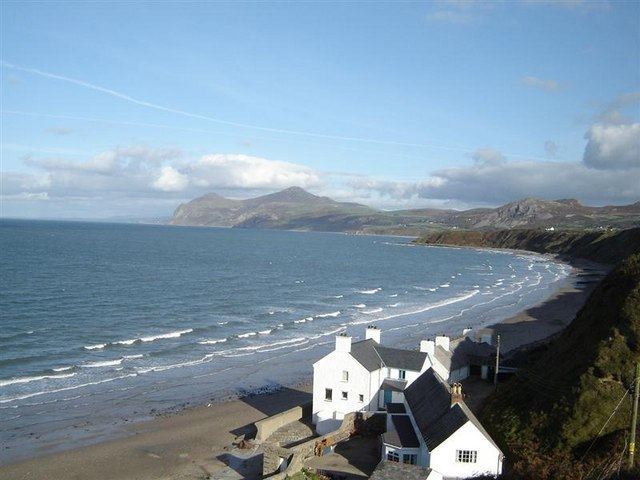Population 2,602 (2011) Community Nefyn Country Wales Local time Thursday 12:16 PM | OS grid reference SH304405 Sovereign state United Kingdom Dialling code 01758 Post town Pwllheli | |
 | ||
Weather 11°C, Wind NE at 27 km/h, 66% Humidity | ||
Morfa nefyn and porth dinllaen in gopro vision
Nefyn ([ˈneːvɨn]) is a small town and community on the north west coast of the Llŷn Peninsula in Gwynedd, Wales. Historically in Caernarfonshire, it has a population of 2,602. Nefyn is popular with visitors for its sandy beach, and has one substantial hotel. Welsh is the first language of almost 73% of its inhabitants. The A497 road terminates in the town centre. The community includes Edern.
Contents
- Morfa nefyn and porth dinllaen in gopro vision
- Map of Nefyn Pwllheli UK
- Holiday cottage nefyn with sea view bwthyn nefyn
- History
- Parish church and origin of the name Nefyn
- 20th century and after
- Governance
- Notable people
- References
Map of Nefyn, Pwllheli, UK
Holiday cottage nefyn with sea view bwthyn nefyn
History
The history of the area can be traced back to 300 BC with the Iron Age hillfort of Garn Boduan overlooking Nefyn. The remains of 170 round stone huts and ramparts are still visible on top of the 917 feet (280 m) hill.
The earliest known reference to Nefyn in documents dates from the latter part of the 11th century, when it is mentioned as a landing place of the Welsh prince, Gruffudd ap Cynan.
Gerald of Wales, writing in his account of a journey around Wales in 1188, says that he slept at Nefyn on the eve of Palm Sunday.
Nefyn was the location of the court of the commote of Dinlaen: part of the cantref of Llŷn.
Edward I of England held a jousting tournament in the town in 1284 to celebrate his victory over the Welsh, emphasising its importance at that time as a trading town. In 1355 it became a free borough and remained an important centre of commerce.
The sea was always an important part of the economy of Nefyn; and fishing, particularly for herring, became the prime trade for most of the 18th and 19th centuries: so much so that the town's coat of arms bears three herrings. Herring were locally referred to as "Nefyn beef". In 1910 Nefyn had 40 herring fishing boats, but herring fishing ceased around the time of the First World War. The area nurtured many ship's captains in the age of sail, and shipbuilding was also an important local industry. About 3 miles to the south-west is Madryn Castle, home of Sir Love Jones-Parry, one of the founders of the settlement of Puerto Madryn in Argentina.
Parish church and origin of the name Nefyn
The foundations of the old St Mary's parish church date from the 6th century, although the present building was erected in 1827. It would have been an important staging post for pilgrimages to Ynys Enlli (Bardsey Island). The old church is no longer a place of worship but houses a museum dedicated to the maritime history of Nefyn. Since 2013, archaeologists have been investigating the area under the church and have uncovered a 13th-14th century brooch and the remains of a lady buried sometime between 1180 and 1250 in an older form of entombment called a cist grave.
Nefyn is now part of a wider ministry area led by former hostage negotiator and Arsenal fan the Reverend Richard Wood.
The name Nefyn is thought to derive from the Irish/Gaelic name Nevin or Cnaimhín. The Romans recorded a tribe occupying the peninsula called the 'Gangani', who are also recorded as a tribe in Ireland. 'Nevin' as a name generally translates as 'Little Saint'. Nefyn is another form of Nyfain, an early Welsh female saint.
20th century and after
Nefyn and District Golf Club was formed in 1907. The course added a further 9 holes in 1912 and a third set of 9 holes in 1933. The current course is made up of a front ten with a choice of two back eights. It is set high on the sea cliffs of the narrow peninsula overlooking Porthdinllaen bay.
Nefyn football club, Nefyn United F.C., was formed in 1932 and has enjoyed some success over the years, winning numerous league titles. At present the senior team competes in the Welsh Alliance League: it was promoted from the Gwynedd League in 2005-06.
During the Second World War, the Royal Air Force built a Chain Home radar station to the south-west of Nefyn.
A tremor in the area on 12 December 1940 was reported by the Cambrian News as having caused two fatalities including John Thomas of Nefyn who died of a heart attack.
On 19 July 1984 an earthquake measuring 5.4 on the Richter scale had an epicentre near Nefyn. This was one of the strongest tremors recorded in Britain for recent times but caused little structural damage.
Nefyn is twinned with Puerto Madryn, a town in Chubut Province in Argentina (see Welsh settlement in Argentina).
Governance
There are two electoral wards within the confines of Nefyn (Nefyn and Morfa Nefyn). The population of Nefyn Ward at the 2011 census was 1,373.
